The Magic of Wild Alaska
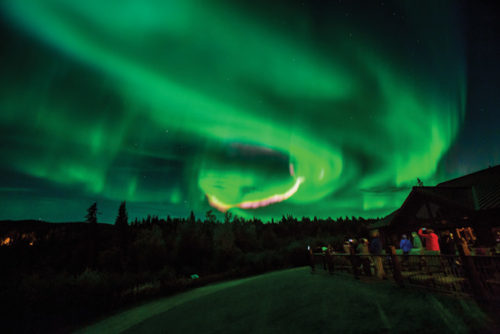
Photo by Laura Grier
You go to Alaska to experience the world on a grand scale — bigger than what you’ll find anywhere else in America. To actually see and get a taste of what our land was like before it was stripped, slashed, fracked, and cluttered with strip malls. As Thoreau wrote, “Think of our life in nature, — daily to be shown matter, to come in contact with it, — rocks, trees, wind on our cheeks! The solid earth! The actual world!”
Yes, think of it! In T.C. Boyle’s novel Drop City, a band of hippies decides to “fall off the map” and head for Alaska because, as one character says, “Alaska’s the real thing, the last truly free place on this whole continent.” It all ends badly, as their idealism masks a remarkable naiveté about what it takes to survive a 40-below winter.
Maybe that’s another reason Alaska fascinates. It can kill you. Plenty have died there, including pioneers, climbers, and of course the gold miners who came at the turn of the 20th century, succumbing to scurvy, dysentery, malaria, typhoid, bears and wolves, or just plain starvation and frigid weather. In modern times, we have the example of Christopher McCandless, a bright but disturbed young man who imagined he could be set free from the blight of civilization if he could but survive alone on the Alaskan tundra. He couldn’t, as you’ll remember from Into the Wild.
Few of us have that kind of death wish, but many nonetheless want to (safely) experience the magic and wonder of this great northern land. My wife, Estelle, and I had the opportunity to do so this past September, traveling with Princess Cruises, which runs many tours of the region, the best of which are land and sea combinations that start you off (or finish you up, depending on which direction you choose to travel) in Fairbanks, roughly the middle of the state. If you travel southward, as we did, you next go by bus down through Denali National Park and then by train to the ship’s debarkation point in Whittier. The ship takes you through Prince William Sound into magnificent Glacier Bay, then down the Inside Passage, with stops at Skagway, Juneau, and Ketchikan, ending in Vancouver or San Francisco.
Along the way, we experienced nature, as advertised, including plenty of animals: moose, bear, caribou, wild mountain sheep, ptarmigan, eagles (bald and golden), whales (humpback and killer), seals, porpoises, and more. Then, there’s the bigger-than-anywhere-else Alaskan landscape: spectacular glaciers, their fissures gleaming azure; the braided, silt-filled rivers that flow from them; the vast, spongy tundra; and the snow-capped spires of Denali (formerly Mt. McKinley), our nation’s highest peak. So much, so big!
Our starting point is subarctic Fairbanks, which, being in central Alaska, is subject to extreme temperature swings, from minus 40-degree (Fahrenheit) days in winter to 90-degree days in summer. It’s also a region where the sun pretty much doesn’t quit in summer, but barely shows up for work in winter. As we were there in the waning days of August, there was already a slight chill in the air, foretelling the savagely cold weather to come. (A local brag is that parking spaces downtown need to be outfitted with electric sockets into which to plug the engine warmers required in cold months.)
For a sample of what that weather feels like, there’s a refrigerated “40 below” room at the embarkation point for the Riverboat Discovery stern-wheeler cruises that ply the Chena River for the benefit of tourists like ourselves. We take the cruise, where 23-year-old Captain Madison Binkley somewhat recklessly allows me briefly to take the wheel. I immediately oversteer coming out of a turn, but she expertly talks me back on track. Afterward, I can’t resist the temptation of the “40 below” experience. You start in an antechamber, like walking into a freezer, then, through another door, you enter a deeper freeze, where the huge thermometer indicates 58 below. Immediately, the inside of my nose starts icing up, and then the cold begins to penetrate my clothes, my skin, my bones. I last about five minutes, but feel the chill for a couple hours afterward.
For its land tours, Princess operates its own hotels. We spend the first night at their Fairbanks lodge, along the Chena River, feasting on salmon and crab legs. Wine tasting, too!
The next day, we’re off by bus to the Denali Princess Wilderness Lodge, just inside the fringe of Denali National Park along the Nenana River. In the afternoon, with a group of eight, I ride a helicopter for a hiking expedition up on the tundra, while Estelle goes whitewater rafting on the river with a young guide who playfully asks, “Hey, want to get wet?” and then, after he promises to fish her out safely if the raft flips, maneuvers them into the frothiest part of the river for a truly wild ride.
For us hikers, it’s a short flight to a ridge at about 4,500 feet, along the way passing a cluster of Dall sheep that look like puffs of cotton clinging to minuscule ledges along the black stone spires. In just a few minutes we reach the tundra, a flat, treeless region where the subsoil is permanently frozen. It looks like a huge meadow set high in the sky — all lichens and mosses and low, hardy grasses interspersed with tiny flowering plants and wild berries. The ground is spongy with snowmelt that sits on top of permafrost. Due to its location, the region gets little rain and wind, so there’s barely any erosion. “We’re looking at a vista that is very likely just as it was at the end of the ice age, about 11,500 years ago,” says our guide.
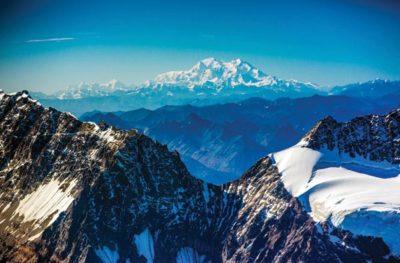
Photo by Laura Grier
It’s a clear day, and about 80 miles away to the south, we make out the 20,310-foot peak of Denali. All around us are steep, treeless mountains, green valleys, and white glaciers, no visible signs of human habitation in any direction, a top-of-the-world feeling.
We start out along a ridge, looking for signs of wildlife — slight depressions where sheep have spent the night, bear scat, caribou tracks. We find geodes, petrified wood, caribou antlers. “Don’t take anything,” says the guide, but I can’t resist slipping a tiny geode and a sliver of petrified wood into my pocket as reminders that this was not a dream.
Descending into a bowl, we come across a patch of mossberries, black in color, bland in flavor — then some cranberries. A golden eagle swoops low over a rise nearby. Suddenly we come across wild blueberries. Kneeling on the ground, staining my pants blue, guzzling handful after handful of the sweet berries, I feel that I could be setting some kind of record, until I learn that grizzlies are capable of consuming up to 100,000 blueberries in a day.
Some signs of change: warmer-than-normal temperatures have melted a steep section of what had previously been permafrost, causing a mudslide that looks like a man-made excavation — which, in a sense, it is. Here and there, we also see fir trees poking up out of the low undergrowth. There are not supposed to be trees of any kind on the tundra, and our guide remarks that about 10 years earlier, when he saw the first invaders pushing through the low undergrowth, he would uproot them as he hiked by, vainly attempting to stop the unstoppable. He pretty soon gave up that battle.
The next day, our group of about 15 takes a school bus into Denali Park. With few exceptions, private cars are not allowed. That means less air pollution and fewer people in the park. Anyone who’s been to the garbage-strewn traffic jams of Yellowstone knows how important that is.
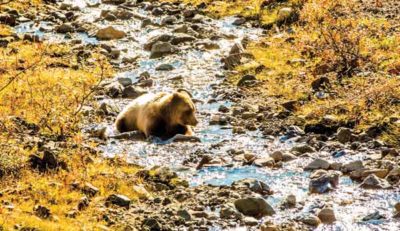
Photo by Laura Grier
The bus is outfitted for sightseeing with oversized windows. There are also video monitors linked to a telescopic video lens controlled by the driver so you can get closer looks at wildlife along the way. And we do see plenty of animals: caribou (a group of four bulls resting together, each one supporting a huge rack of antlers, the velvet peeling off in loose tatters), a moose, then suddenly a large male grizzly. The bear is cooling off in a stream, mere yards from the road, panting like a dog on a hot day. After several minutes, he clambers to his feet, shakes off, and disappears into the brush.
The turnaround point is about 40 miles in, just over a rise, giving way to a view of Denali. The mountain is glorious, and importantly, visible. Denali, which has its own microclimate, is frequently enveloped in clouds even on a sunny day. But here it is!
Late afternoon brings another helicopter excursion, this time to a glacier. Stepping off the copter, looking out across the vastness of the ice, the deep blue shade of the pooling meltwater, the immensity of the mountains roaring up around us, I am, for a moment, ecstatic. (“The actual world!”)
The night brings more spectacle, the aurora borealis enhancing the sky in swirling greens, reds, and purples — a light show I will never forget.
The next day begins with a long bus ride to Princess’ McKinley lodge, where, thanks to another crisp, clear day, we are treated again to a spectacular view of the mountain — this time from the south side.
In the afternoon, we head to the nearby one-horse town of Talkeetna, which accommodates tourists and serious mountain climbers with equal affability and a bit of Wild West edginess. (A sign at an ice cream shop warns playfully, “Patrons taking more than 3 seconds to choose a flavor will be shot.”) From multiple choices of excursions — horseback rides, float trips, flightseeing tours — Estelle and I choose a jet boat ride that takes us up and around three rivers (the Chilitna, Talkeetna, and Susitna, each one a slightly different shade of silty gray). The water is shallow (hence the need for the jet boat, which only draws about one-and-a-half feet of water), swirling around boulders and logs, forming Rorschach patterns on the surface, challenging the captain. Several bald eagle sightings, including one bird that swoops low, maybe 10 feet over our boat. The boat is glassed in, but Estelle and I step out onto the tiny rear deck for fresh air. Above us, a deep blue cloudless sky and piercing sun. Around us, only rushing water and still woods. The wind blows Estelle’s hair in her face and she laughs with joy. Damn, she looks good! Forty years of marriage, but I just can’t help myself; I’m falling in love all over again.
A day later, we’re back in Talkeetna for a small-plane tour up and around the spires of the Alaska Range, ultimately within 500 feet of Denali itself. After the plane ride, a quick stop for lunch and a flight of delicious beers at Denali Brewing Company, and then almost before we can clean our plates, it’s off to the Alaska Railroad station, just outside of Talkeetna, where railway cars await to take us down to our ship in Whittier.
It’s raining in Whittier. It’s always raining in Whittier, which ranks as one of the top 10 rainiest cities in America. We dash under awnings for the short walk to the Star Princess. She’s one of the larger cruise ships, 951 feet long, 201 feet high, capable of holding 2,600 passengers. To give you an idea of the scale, each week the 150 galley staff bake upwards of 24,000 fresh bread rolls, grind nearly 3,000 pounds of beef for burgers, and serve more than 10,000 slices of pizza. Over the course of the voyage, let’s just say we are well fed: crab legs, salmon, steak, shrimp, lamb chops — sometimes all of the above. But overindulging is one of the perks of taking a cruise, and who are we to argue?
One day in, we find ourselves anchored in Yakutat Bay, just a few hundred yards from Hubbard Glacier. This massive display of nature’s power is sooty black and white, with streaks of blue light flaring through the cracks. The leading edge stands 350 feet high and extends another 250 feet below water. We crowd the forward deck, 12 stories high, about midway up the side of the front glacier wall, oohing and aahing as city-building-sized chunks break off (a process known as calving) and fall into the sea with cannon-like booms. These ice chunks are 400 years old, having traveled 76 miles down the valley from the mountains beyond, moving like a very slow river at a pace of just a few feet each day.
Two days later, we make Skagway, the first of three stops in small historic Alaskan towns, visiting one per day. While many passengers disembark to roam the streets hunting for deals on hats, sweatshirts, and jewelry, for me, the secret is to sign up for one of the excursions that get you out of town. At each stop, there are numerous options, from flightseeing to rafting to train rides to hikes in the woods.
At Skagway, I’ve booked a tour to a dogsled camp, which requires a bus ride out of town, transferring to a four-track to navigate a steep logging road that leads to the camp. Up in the high country, we meet and play with sled dogs and are taken for a spin in a (wheeled) sled pulled by a dog team. Running the one-mile circular track is a lark for these canine master-athletes — the dogs howl and bark in anticipation of the command “mush!” seeming to want nothing so much as to run.
There’s a somewhat touristy feel to this excursion — the way we’re expertly moved from the dog sled lecture station to the pet-the-puppies kennel to the 10-minute dogsled ride to the gift shop, all in about an hour — but what makes it authentic is that these are real working sled dogs. They’re here, not for our benefit, but to train for their winter in competitive dogsled races like the 1,000-plus-mile Iditarod from Anchorage to Nome, during which they will run at an average pace of 10 to 12 miles per hour for five-hour stretches, followed by five hours of rest, on and off for eight to ten days straight. As the Iditarod race approaches the northern city of Nome, temperatures routinely get down to 40 below or colder, so frostbite is a serious hazard. We learn that it’s common for sled drivers to be missing a finger or two. The dogs are better protected, thanks to the natural insulation of their coats. In fact, we learn the only part of the sled dog that isn’t safe from frostbite is the penis. (Special doggie pants are fitted on the males for the coldest parts of the run.)
A day later, in Juneau, Estelle and I take a bus ride out of town, happily skirting the touristy hustle (“Closeout Diamond Sale!,” “$5 T-Shirts!”) to go on a short nature hike to Mendenhall Lake, about a mile across, looking at the terminus of the Mendenhall Glacier. About 120 years ago, there was no Mendenhall Lake, only the glacier.
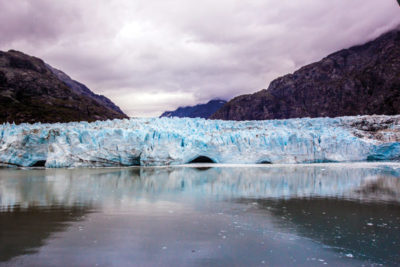
Photo by Laura Grier
Another day at sea and we’re in Ketchikan, where we’ve signed up to go salmon fishing. As we walk along the dock to the small fishing boat, the gloomy captain greets us with a warning that “this has been the worst fishing season in 40 years.” And indeed, out of four boats that go out that morning as part of our group, only three legal salmon are caught — none in our boat. Still, even with slack fishing lines, it’s a beautiful day on the water, with a pod of humpback whales spouting and diving nearby.
For the dearth of salmon in the waters, our captain blames “fish factories,” the mammoth ships of foreign registry that scour the sea floor just beyond our territorial waters for everything and anything they can dredge up. These boats are taking in excessive quantities of herring, he says, which the humpback whales normally feed on in addition to plankton and shrimp-like krill. He theorizes that the whales turn to salmon fingerlings when herring is in short supply, and as a result, the precious salmon population takes a hit.
Two days later, we’re in Vancouver, the end of the line. We spend a day there, and I rent a bicycle to take a ride around Stanley Park, with its terrific views of the harbor. I watch as the Star Princess, fully loaded and replenished, disembarks for the return trip up to Whittier.
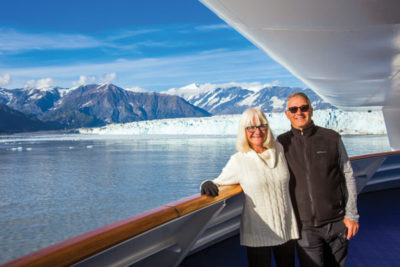
Photo by Laura Grier
Across the harbor, the ship is grand. But you don’t take the Alaska cruise to experience the ship. You go for the pristine landscape, for the diverse wildlife, and for indelible memories of flying through heaven-scraping mountains, hiking on frozen tundra, watching eagles soar and whales spout and dive, witnessing a glacier slowly melting before the inexorable onslaught of a warming climate, and thrilling to those amazing northern lights — the greatest light show on the planet.
Steven Slon is editorial director of The Saturday Evening Post. In the last issue, he interviewed artist Mort Künstler. See more of Laura Grier’s awe-inspiring travel photography at lauragrier.com.